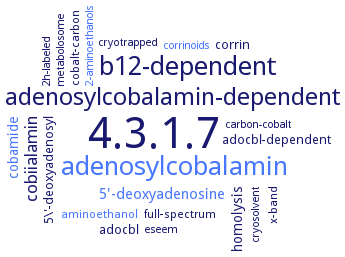4.3.1.7: ethanolamine ammonia-lyase
This is an abbreviated version!
For detailed information about ethanolamine ammonia-lyase, go to the full flat file.

Word Map on EC 4.3.1.7 
-
4.3.1.7
-
b12-dependent
-
adenosylcobalamin
-
adenosylcobalamin-dependent
-
cobiialamin
-
5'-deoxyadenosine
-
homolysis
-
cobamide
-
corrin
-
5\'-deoxyadenosyl
-
adocbl
-
adocbl-dependent
-
cobalt-carbon
-
aminoethanol
-
x-band
-
full-spectrum
-
metabolosome
-
2h-labeled
-
carbon-cobalt
-
cryotrapped
-
cryosolvent
-
2-aminoethanols
-
corrinoids
-
eseem
- 4.3.1.7
-
b12-dependent
- adenosylcobalamin
-
adenosylcobalamin-dependent
-
cobiialamin
- 5'-deoxyadenosine
-
homolysis
- cobamide
-
corrin
-
5\'-deoxyadenosyl
-
adocbl
-
adocbl-dependent
-
cobalt-carbon
- aminoethanol
-
x-band
-
full-spectrum
-
metabolosome
-
2h-labeled
-
carbon-cobalt
-
cryotrapped
-
cryosolvent
- 2-aminoethanols
- corrinoids
-
eseem
Reaction
Synonyms
AEL, ammonia-lyase, ethanolamine, EAL, ethanolamine ammonia lyase, ethanolamine ammonia-lyase, ethanolamine ammonia-lyase BMC, ethanolamine deaminase, ethanolamine-ammonia lyase, eut-L, EutB, eutBC
ECTree
Advanced search results
Crystallization
Crystallization on EC 4.3.1.7 - ethanolamine ammonia-lyase
Please wait a moment until all data is loaded. This message will disappear when all data is loaded.
deletion mutants of the enzyme beta subunit DELTA4-30 and DELTA4-43, to 8.0 and 2.1 A resolution, respcetively
For crystallization trials, protein sample is dialyzed against 50 mM HEPES with pH 7.0 and concentrates to a final concentration of about 1 mg/ml. Purification results in highly pure protein that crystallizes readily under many different conditions, protein forms thin hexagonal plate-shaped crystals belonging to space group P3. Best crystals of Eut-L_NHIS are obtained in 3.3 M ammonium acetate, 5% polyethylene glycol 400 and 50 mM Tris buffer pH 7.5, crystals grow as hexagonal plates. Eut-L_CHIS crystals grow as single hexagonal plates with sharp edges. Crystals grow in 2 M NaCl, 100 mM phosphate, 100 mM MES buffer pH 6.5 and 4% PEG 400.
-
N-terminal His6-tagged beta subunit lacking residues Lysbeta4-Cysbeta43, complexed with CN-cobalamin and (R)-2-amino-1-propanol or (S)-2-amino-1-propanol. The lower affinity for the (R)-enantiomer may be due to the conformational change of the ValR326 side chain of the enzyme. The pro-S hydrogen atom on C1 is abstracted by the adenosyl radical from both enantiomeric substrates. The NH2 group migrates from C2 to C1 by a suprafacial shift, with inversion of configuration at C1 for both enantiomeric substrates. (R)-2-amino-1-propanol is deaminated by the enzyme with inversion of configuration at C2, whereas the (S)-enantiomer is deaminated with retention. The rotameric radical intermediate from the (S)-enantiomer undergoes flipping to the rotamer from the (R)-enantiomer before the hydrogen back-abstraction, suggesting the preference of the enzyme active site for the rotamer from the (R)-enantiomer in equilibration, partly explained by steric repulsion of the (S)-enantiomer-derived product radical at C3 with the PheR329 and LeuR402 residues
N-terminal His6-tagged beta subunit lacking residues Lysbeta4-Cysbeta43, in complex with cyanocobalamin and in complex with cyanocobalamin or adeninylpentylcobalamin and substrates. The enzyme exists as a trimer of the (alphabeta)2 dimer. The active site is in the (beta/alpha)8 barrel of the-subunit, the beta-subunit covers the lower part of the cobalamin that is bound in the interface of the alpha- and beta-subunits. The structure complexed with adeninylpentylcobalamin reveals the presence of an adenine ring-binding pocket in the enzyme that accommodates the adenine moiety through a hydrogen bond network. The substrate is bound by six hydrogen bonds with active-site residues. Arg160 contributes to substrate binding most likely by hydrogen bonding with the O1 atom. Marked angular strains and tensile forces induced by tight enzyme-coenzyme interactions are responsible for breaking the coenzyme-Co-C bond. A major structural change upon substrate binding is not observed with this particular enzyme. Glu287, one of the substrate-binding residues, has a direct contact with the ribose group of the modeled adenosylcobalamin, which may contribute to the substrate-induced additional labilization of the Co-C bond


 results (
results ( results (
results ( top
top





